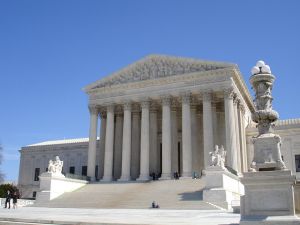In October 2013, the U.S. Supreme Court granted certiorari in the case of Chamber of Commerce et al v. EPA et al. The case will decide the question of “(w)hether the EPA [Environmental Protection Agency] permissibly determined that its regulation of greenhouse gas emissions from new motor vehicles triggered permitting requirements under the Clean Air Act for stationary sources that emit greenhouse gases.”

The grant of certiorari followed Texas Attorney General Greg Abbott’s petition to the Court in April 2013, along with 11 other state attorneys general. The 11 other states involved, in addition to Texas, are Alabama, Florida, Georgia, Indiana, Louisiana, Michigan, Nebraska, North Dakota, Oklahoma, South Carolina and South Dakota. The attorneys general argued in their petition that the EPA violated the Constitution as well as the federal Clean Air Act by “concocting” its greenhouse gas regulations without Congressional authorization. Attorney General Abbot said that the regulations are threatening Texas jobs and employers and the EPA is a “runaway federal agency”. He was pleased the Obama administration would have to defend these regulations before the Supreme Court.
Organizations representing the oil and gas industry were also pleased that the Supreme Court decided to take this case. These organizations include the American Petroleum Institute and the American Petrochemical & Fuel Manufacturers. The issue doesn’t effect just the energy and manufacturing industries. Millions of other stationary sources could be affected by strict permitting requirements according to the president of the National Association of Manufacturers, who said that the regulations threaten the global competitiveness of the U.S.
Harry Ng, API’s vice president, applauded the move and said that “(t)he Clean Air Act clearly only requires preconstruction permits for six specific emissions that impact national air quality-not greenhouse gases. That kind of overreach can have enormous implications on U.S. competitiveness and the prices that consumers pay for fuel and manufactured goods.” The General Counsel of AFPM, Rich Moskowitz, echoed that under the EPA’s current regulations the Clean Air Act’s Prevention of Significant Deterioration program would be turned into a “far-reaching regulatory program” that might apply to sources Congress didn’t originally intend and would impose “onerous permitting requirements.” He continued that the “EPA does not have the authority to rewrite specific statutory emission limits in an effort to avoid the absurd results created by its attempt to use GHGs as a regulatory trigger under the PSD program.” The American Chemistry Council also issued a statement in support of the Court’s granting of certiorari, which said in part: “We hope the Court will correct EPA’s egregious misreading of the Clean Air Act, which even the agency concedes leads to ‘absurd results.”
An amicus brief in the case stated the EPA had “opened a pandora’s box” of expansive greenhouse gas regulation that is likely to spread to the entire economy. People across the U.S. should be paying close attention to this case, as it not only affects the oil and gas and manufacturing industry, but the overall health of the economy. The Supreme Court’s decision has the potential to have a big impact.
See Our Related Blog Posts:
 Texas Oil and Gas Attorney Blog
Texas Oil and Gas Attorney Blog

